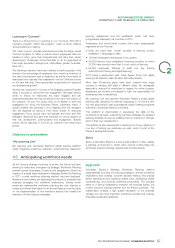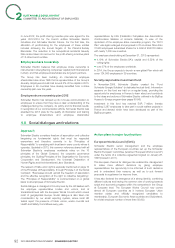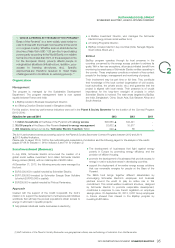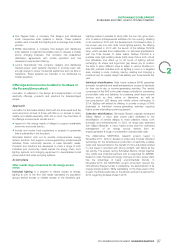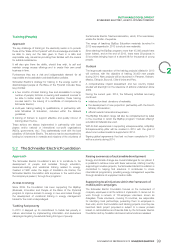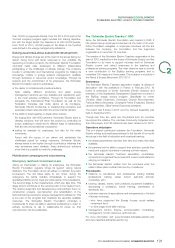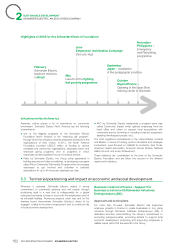APC 2013 Annual Report Download - page 99
Download and view the complete annual report
Please find page 99 of the 2013 APC annual report below. You can navigate through the pages in the report by either clicking on the pages listed below, or by using the keyword search tool below to find specific information within the annual report.
SUSTAINABLE DEVELOPMENT
SCHNEIDER ELECTRIC, AN ECO-CITIZEN COMPANY
One Degree Solar, a company that designs and distributes
l
Lighting makes it possible to study after the sun has gone down
small, inexpensive solar systems in Kenya. These systems and to extend entrepreneurial activities into the evening. Building
enable users to benefit from lighting and to recharge their mobile on its success in 2010 with the development of Homaya In-Diya, a
phones; low-power, very low cost, solar home lighting system, the offering
was completed in 2013 with the launch of the Mobiya TS120S
FENIX International: a company that designs and distributes
l
lamp, which resulted from collaboration on technical specifications
solar systems in Uganda that enable users to develop a mobile with the Total Access To Solar teams. Mobiya TS120S is a
phone charging business. This company has established portable solar light-emitting diode (LED) lamp that is both robust
distribution agreements with mobile operators and has and affordable and offers up to 48 hours of lighting without
developed a prepayment offering; recharging. Its shape and ergonomic grip allows you to position
Lumos International: this company designs and distributes
l
the lamp in seven different ways to adapt to various situations in
2
medium-power solar systems intended to provide users with daily life: practical activities such as lighting a room or a targeted
enough energy to power household appliances such as fans or area, marking a route, cooking, sewing, reading and charging a
televisions. These systems are intended to be distributed by mobile phone. Its original design has already won three awards this
mobile operators. year.
Offerings and economic models for the Base of
Individual electrification: Solar home systems (SHS) guarantee
domestic households and small entrepreneurs’ access to electricity
the Pyramid (Innovation)
for their day-to-day or income-generating activities. The central
component of the SHS is the solar charge controller for connecting
Innovation is reflected in the design and implementation of rural photovoltaic cells and batteries for powering small direct-current
electricity offerings, products and solutions for disadvantaged devices such as fans, radios or televisions, as well as
people. low-consumption LED lamps and mobile phone recharging. In
2014, BipBop will extend its offering to provide a range of SHS
Approach
dedicated to individual income-generating activities requiring
higher-power alternating-current equipment.
Innovation for Schneider Electric starts with the local needs and the
socio-economic context of those with little or no access to clean, Collective electrification: Schneider Electric originally developed
healthy and reliable electricity. With this in mind, the chief aims of Villaya Villasol, a micro solar power plant dedicated to the
its offerings and economic models are to: electrification of remote villages to meet collective needs, both
domestic and entrepreneurial. In 2012, its range was extended
respond to the energy needs of villages to support sustainable
l
with Villaya Villasmart, a micro hybrid power plant for optimized
economic and social activity; management of an energy source derived from an
include and involve local populations in projects to guarantee
l
engine-generator through a combination of photovoltaic cells.
their sustainability in the long term. The collaborative MiCROSOL research project, begun in
Schneider Electric sets out to provide comprehensive energy November2011, aims to develop a unique and modular standard
access solutions that support revenue-generating entrepreneurial technology for the simultaneous production of electricity, potable
activities, foster community services or meet domestic needs. water and heat primarily for the benefit of micro-industries located
Products and solutions are developed to meet a range of both in rural areas in countries with strong sunlight, with Africa as the
individual and community needs across the energy chain, from top priority. The project, led by Schneider Electric, brings together
lighting systems and charging equipment to decentralized small nine public and industrial partners and is supported by ADEME.
power plants and water pumping systems. Based on solar thermal technology, this type of micro power plant
Action plans
has the advantage of being environmentally friendly. In
November2013, the MiCROSOL project consortium opened the
Offer a wide range of services for all energy access
CEA (Atomic Energy Center) in Cadarache, the demonstrator of its
needs
energy access solution. While capitalizing on the three years of the
Individual lighting: In a program to extend access to energy, project, the first live pilot site on the African continent is planned for
lighting is one of the first vital needs expressed by population 2014, beginning its sales phase in 2015.
groups denied access or reliable access to the electricity grid.
97
2013 REGISTRATION DOCUMENT SCHNEIDER ELECTRIC


